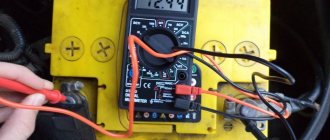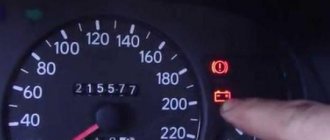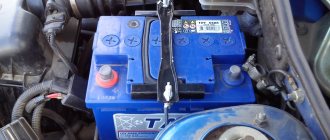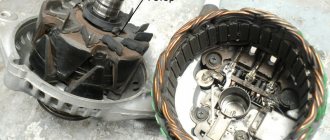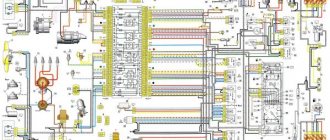Causes of broken or loose terminals
- Frequent removal of the battery or “throwing away” terminals. To connect the battery to the car, terminals made of soft metals such as lead, copper, aluminum, and brass are used. Due to frequent removal and installation, their clamping force disappears, and in some cases the terminal is completely destroyed
- Too much effort
when tightening. Despite the fact that the metal is soft, when tightening too much force, the terminals can crack or break off - High heat. If there is poor contact or problems with the wiring, the terminals may become hot, causing them to become deformed.
Replacing the positive battery terminal
If there is a need to replace the positive terminal, select the desired terminal from the pair. The sequence for removing and installing the component is the same for both electrodes.
- Remove the contacts from the wire, then release the anode from the clamp placed on top.
- Clean the contact and prepare the wires for installation.
- First of all, connect the high-voltage cables from the on-board network and additional wires from the music center.
- Place the contact on the anode pin and secure it to it.
You might also find a practical guide on how to properly tighten terminals, video, useful
The materials used to make terminals for car batteries are usually brass or lead. But no matter how durable the metal is, it is characterized by “fatigue,” which in turn leads to failure of the battery mounts. To replace, stock up on a new battery terminal, sandpaper, a knife and two 12 and 10 mm wrenches.
A new terminal for the battery must be purchased in accordance with the broken terminal (negative or positive), since they differ in diameter. In addition, the terminals may have a different clamping system (rotary or screw), but here you can choose any option according to your desire.
Before you replace the battery terminal with your own hands, do the following: if the car is running, turn off the ignition and remove the key from the ignition switch. The car is removed from speed and put on the handbrake. Next, open the hood and disconnect the battery terminals. Be sure to disconnect the negative terminal first and only then the positive one. This is done to protect all electronic systems of the car, because if there is no potential in the “ground”, the car electronics will not suffer as a result of a possible short circuit.
To remove the terminals, you need to use a 12 mm wrench and unscrew the side bolt securing the terminal to the battery. If you don't have a wrench of the appropriate size, you can use pliers or an adjustable wrench. The broken terminal is cut off at the place where it is connected to the cable, from which the braid is then carefully cut off using a knife.
Next, using sandpaper, we clean the contacts from the insulating coating. On the new terminal being installed, we unscrew the clamping bolts, which will require a 10 mm wrench, since here the bolts are smaller. We insert the wire at such a distance that its stripped ends peek out from under the holder. Using a 10mm wrench, you will need to tighten the bolts enough to create a strong but neat connection. In the reverse order, we connect the terminals to the battery, putting on and securing with a 12 mm wrench first the positive terminal and then the negative terminal. Now you can try to start the car engine. If the engine starts normally, the work of replacing the terminal is considered completed. However, if you are afraid that replacing the battery terminal yourself is beyond your capabilities and you are afraid that you may get confused in the order of the necessary actions to correctly perform this repair operation, it is better to ask for help from service specialists.
Consequences
Poor contact at the battery terminals leads to a decrease in the efficiency of all electrical systems of the car.
The most common problem is rapid battery drain.
when parked for a long time. At some point, the car may simply not start. Poor contact is also associated with poor operation of the starter when starting.
Oxidation of contact pair
. The formation of a white coating on the terminals and electrodes of the battery is the consequences of oxidation, which occurs from poor contact. As a result, problems arise with charging the battery while driving and its rapid discharge when parked.
Increased load on high-voltage wires
. This can lead to the wire burning out or a fire (many people cover the engine with flammable fabrics in winter).
Damage to vehicle electrical equipment
. When starting the engine, voltage surges occur, which negatively affect the devices and can damage them.
Which terminal is removed first when replacing the battery?
Before carrying out repairs, you must turn off the car's ignition and disconnect the battery. The negative terminal is always removed first, then the positive one. This will protect the vehicle’s on-board system from accidental short circuits. How to replace the battery terminal is clearly shown in the video.
It is necessary to remove the battery and remove it from the “shelf”. Only after freeing the tight space should you begin to disconnect the wire from the terminal. How to replace the contact on the high side? To do this, you need to either loosen the bolts or straighten the clamp. If you have to cut off stuck wires, the remaining part may not be long enough to restore the connection. Then it is best to install a fashionable terminal. It shows the voltage, and is 5-7 cm longer than the standard one. Methods of extending the wire with a piece of the same cross-section are also used.
Before installing a new terminal, you need to make sure that the insulation of the high-voltage wires is intact. The wires are inserted into the holders so that they come out of the mount. The braid and other insulation are first removed. After tightening the bolts, the protruding remainder of the wire is insulated.
Selecting terminals when replacing
There are a large number of battery terminals available on the market. Before replacing the old terminal, you need to know how to select a new one.
The part must match the size of the electrodes on the battery, otherwise it will not fit or tighten. The size of the terminal should be such that when tightened tightly there is a margin of 3-5 mm.
It is also necessary to match the diameter of the hole for the high-voltage wire, which must be tightly secured in the terminal.
When choosing the material from which the terminal is made, preference is given to lead. It has good conductive properties, is soft enough for crimping and does not form a galvanic couple with the battery electrode. If you cannot find these, you can use brass or copper.
Those who use modified acoustic systems in their car, with a large number of components, should pay attention to the terminals that have additional places for attaching power wires.
There are also kits on sale that consist of a terminal with a pressed wire. This replacement option is preferable, but requires more effort.
If your car does not have a protective cover for the positive terminal, it is advisable to purchase it separately. It will protect the connection from foreign moisture, dust, as well as from accidental short circuit of the “plus” to ground.
An important role is played by the ability to quickly remove the terminals from the battery, since when carrying out repair work or a short circuit occurs in the electrical wiring, you need to turn off the power to the car.
Replacing battery terminals
Replacing battery terminals is not the most difficult task that car owners have to face, so there should not be any particular difficulties in the process of this work.
Battery terminals are placed on the battery electrodes and connect voltage cables to them, which supply the vehicle's electrical network with current. Terminals are made from different metals - brass, lead, copper, aluminum. They come in different shapes and types, but they have one thing in common - over time, oxidation appears on them, they rust and literally crumble before our eyes.
If you notice that it is time to replace the terminals, then you must first purchase a new kit and begin replacing them.
Each terminal has a designation - minus and plus; the negative contact of the battery is usually thicker. Stop the car on level ground, turn off the engine, turn off the ignition, put on the handbrake and neutral gear.
Then you need to remove the terminals from the contacts. They are attached using 10 or 12 bolts, unscrew and remove. Need to remember:
- First you need to remove the negative contact - minus, ground. If you violate the order of removing the terminals, a short circuit may occur and all electronics will burn out.
- Then we disconnect the positive contact from the battery electrode. You need to remember which wire is which.
The cables are secured to the terminals using clamping bolts and inserted into special fasteners. If the length of the cable allows, then you can simply cut the end of the wire with a knife or any sharp object at hand, but if not, then unscrew the bolts with keys of the appropriate diameter. If you don’t have keys at hand, you can take pliers, an adjustable wrench, or, as a last resort, you can stop someone and ask for the necessary tools.
After removing the terminals from the battery contacts, the latter must be cleaned of scale, oxides and corrosion using sandpaper or a brush.
You can also get rid of oxides with a solution of soda and water, after which the contacts need to be cleaned. To prevent them from rusting, they are lubricated with grease, lithol, technical petroleum jelly or special anti-corrosion varnishes.
When you have sorted out the battery contacts, you need to insert the wires into the terminal holders so that the ends of the wires protrude slightly from under the mount. To do this, you need to strip the insulation and braiding of the wire with a knife and get directly to the copper conductors. Tighten the holder bolts to maximum. First put on the positive contact. Then put the wire on the negative terminal in the same way.
When the battery is reconnected to the car's electrical system, you can try to start it. As you can see, there is nothing particularly dangerous or complicated here. The main thing is not to confuse minus and plus.
Video on how to restore battery terminals.
( 2 ratings, average: 3.00 out of 5)
Replacement
For replacement, we suggest you watch this video:
Before carrying out work, you must turn off the ignition and disconnect the battery. Most drivers know which terminal is removed first, but do not always follow this sequence. Breaking the order is important from a security point of view. If the “plus” is accidentally shorted to ground, the electronics and electrics of the car can be damaged, so first of all, the negative terminal is removed from the battery, and then the positive one.
Next, you need to remove or loosen (depending on the design) the battery mount and remove it from the “shelf”. It is strictly not recommended to replace the terminals with the battery installed!
Next, you need to disconnect the terminals from the high-voltage wires. If they are secured with a bolt clamp, then you need to loosen the tension and remove the wires. If the wires are crimped by the terminal body, use tools to loosen or completely unbend the clamp and pull out the wire.
If you cannot free the wires from the terminals, you can cut each of them and measure the length, since after cutting they may not be enough to reach the battery electrodes.
After dismantling the old terminals, you need to check the integrity of the wire insulation, and then install new ones.
The battery is connected in the reverse order - first the positive terminal, then the negative one. Before connecting, if necessary, clean the electrodes on the battery.
Which terminal should be removed first?
Before you begin to replace the contacts for connecting to the battery, you need to perform several preparatory measures.
Some motorists make the mistake of choosing the wrong terminal when removing it, which should be removed first.
When replacing terminals or any other operation that involves removing battery contacts, the negative terminal is always disconnected first.
The sequence of preparation itself can be represented as follows:
- turn off the ignition, remove the key from the lock;
- wait about 15 minutes, letting the car just stand;
- using keys or other tools, disconnect the negative terminal;
- only then disconnect the plus;
- fix the wires so that they do not touch the battery terminals;
- wipe the surface with a dry cloth;
- if there are traces of electrolyte on the case, use a solution of water and soda, wiping the battery with a rag soaked in it;
- if there is a bottom lock for installing the battery, unclip it;
- remove the battery from the engine compartment.
That's it, now you can start replacing.
Which terminal should be removed from the battery first?
Among car enthusiasts, there is an opinion that when removing a battery from a car, you should first remove the “minus” terminal and then the “plus” terminal. Few car owners will be able to explain where such a rule came from. If we talk from the point of view of battery safety, then it makes no difference which terminal is removed from the battery first, but we strongly recommend that you adhere to the rule: “ the negative terminal is removed first .”
The answer to the question why it is recommended to start dismantling the battery from the minus terminal is quite simple. If you first remove the terminal from the “plus” and take it to the side, and then take on the “minus” terminal, then there is a high risk of a short circuit. It will happen if by chance the terminal that was connected to the “plus” of the battery is connected to ground. If you initially disconnect the minus terminal, which is shorted to the car body, then nothing bad will happen even if it is accidentally connected to ground.
Causes of destruction and loosening of battery terminals
The terminals are made of soft metal alloys or pure metals copper, aluminum, lead, brass. The products completely cover the contacts, but every time the battery is removed, the sockets quickly become damaged, cracks appear, and the threads become clogged. Each time the contact tightens worse, the clamping force disappears. Sometimes a crack appears or the knot falls apart.
If you use too much tension, you can even break a new loop. But if the contact is weak, it will weaken further during movement, sparking and heating will begin, leading to deformation.

